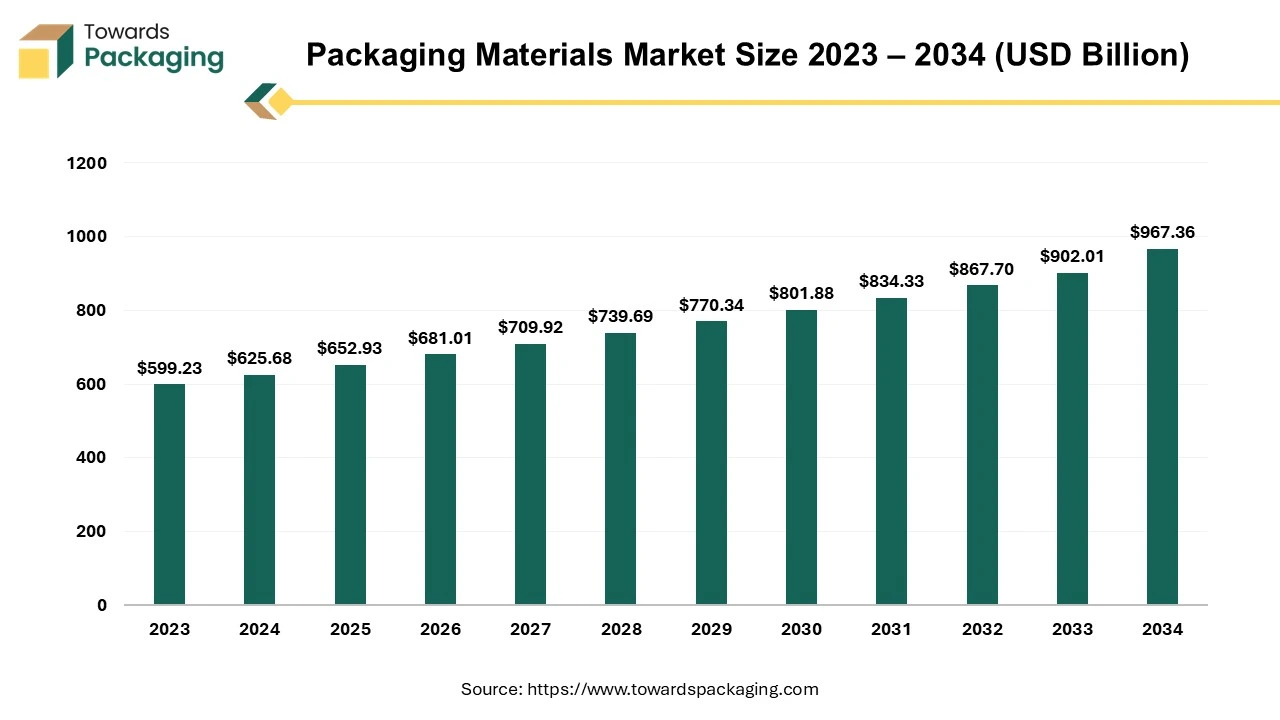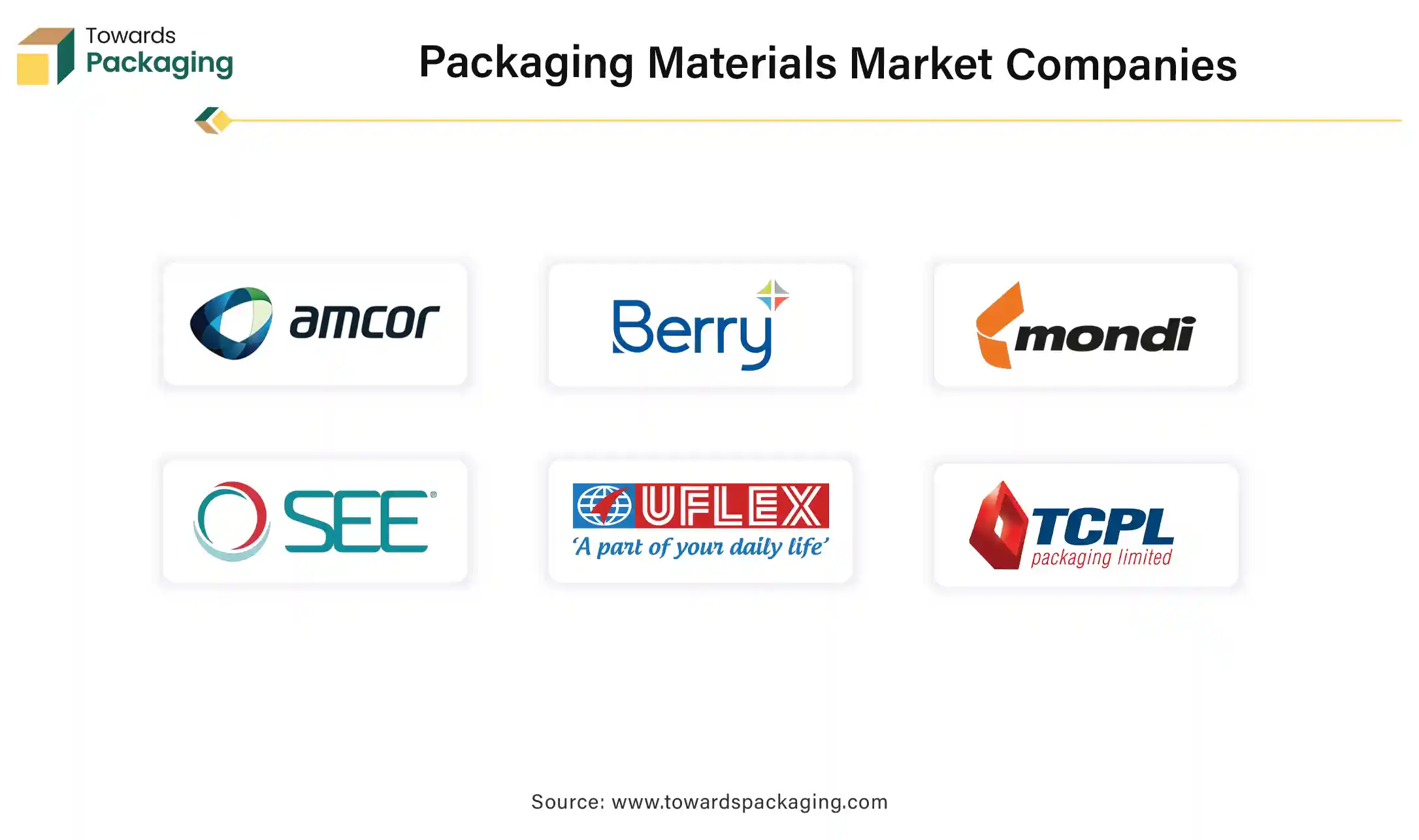April 2025
The packaging materials market is forecasted to expand from USD 652.93 billion in 2025 to USD 967.36 billion by 2034, growing at a CAGR of 4.45% from 2025 to 2034.

Consumers widely accept this market due to the growing e-commerce platforms, which influence people to order products online that require safe packaging for storage and transportation. The rising demand for sustainable, multi-useable, and innovative packaging among consumers also boosts the development of the packaging materials market.
The packaging materials market plays a significant role in various sectors such as e-commerce, healthcare, the food & beverages industry, and many others where the packaging of products boosts the business profoundly by enhancing the reliability of customers. Several brands try to create their unique packaging to attract a huge number of customers which allows companies to invest widely in this market. Continuous advancement in the packaging sector such as accessibility to a wide range of shapes and sizes of packages, sealable packages, personalized packaging, and many such advancements led to the development of the packaging material sector.
The rising focus on eco-friendly packaging, reusable packaging, biodegradable resources, and many such concerns has expanded the potential of this market. Growing concern for product safety while transporting to a longer distance to aesthetic packaging trends requires the market players to choose packaging materials carefully to fulfil the demand of the consumers.
The incorporation of AI in the packaging materials industry has significantly influenced the market with its requirements for improved quality production of packaging products. AI can help to detect enhanced quality resources which can be moulded into desired shapes, sizes, and patterns of the packaging. AI is highly preferred in inventory management, quality control, predictive maintenance, and supply chain optimization.
The unique design of packaging requires high-quality material which can be easily predicted with artificial intelligence. This advanced technology integration helps in labelling automation, out-of-the-box designs, and smart packaging. To provide a personalization option in the product there is a huge role of AI in addition to techniques according to the packaging materials used.
The growing demand for advanced technology packaging products has increased the focus of the market players towards the materials used for packaging purposes. This phenomenon can be accredited to a convergence of problems that are redesigning the global corporate landscape.
Firstly, the growing middle-class people in developing markets are progressively driving consumption. With the rise of disposable incomes, the demand for well-packaged products extended from personal care products to food and beverages and electronics. This rise in demand imposes effectual and operative packaging choices to preserve goods' quality, confirm safety, and improve shelf appeal.
Moreover, the speedy urbanization and automation of all the developing areas contribute to the growth of the packaging industry. Urbanization contributes to better availability of modern retail stores, which results in a boost in the requirement for packaged goods. Additionally, the increase of online platforms, simplified by refining digital organization and connectivity, needs safe and attractive packaging choices to safeguard goods during transportation, improving the consumers' experience.
With the developing business site, sustainability has appeared as a supreme apprehension for both customers and enterprises. The packaging sector, an important constituent of the worldwide supply chain, is facing a noteworthy alteration as a consequence of this everchanging pattern. There is a growing demand for supportable and environment-friendly packaging choices, determined by heightened ecological consciousness and the authority to decrease natural footprint.
Customers, above all, are making mindful choices, and they are requesting that the goods they buy are not only of enhanced quality but also packed in a way that reduces damage to the atmosphere. Concurrently, industries are understanding the status of aligning with sustainable utility to meet regulatory needs and improve their brand image.
With such refined quality of packaging products, there is a huge rise in the pricing of the packaging which ultimately increases the charges of the product, this hinders the growth of the packaging materials market. Several market players are searching for ways that can help to use materials which are eco-friendly as well as low in price.
The rigid plastic packaging materials market is important in the raw material segment of this market during the predicted period. These types of packaging are extensively used in pharmaceutical sectors for packaging a variety of products that require long-term storage. Its high-strength bottles and other packaging are convenient to use for the customers. Such packaging is reusable and hence attracts a wide range of consumers and hence companies are majorly focusing on such packaging materials that can last longer and also be refilled and used multiple times. These rigid plastics can be easily recycled which makes them most preferable for both consumers and companies.
Boxes and carton segment led the market in 2024 and is observed to sustain the position during the forecast period due to the rising demand for safe transportation of products. Boxes and cartons are versatile and fundamental packaging goods that play an important role in the packaging sector. These goods help as defensive methods of packaging for a variety of products, confirming safe storing, presentation, and transportation.
Boxes and cartons are manufactured in several materials, shapes, and sizes, making them flexible to a variety of packaging requirements. Boxes are generally made up of corrugated cardboard and are famous for their stackability and durability. They are usually used for storage, shipping, and show purposes. These packaging goods offer numerous benefits.
The primary packaging segment led the market in 2024 and is observed to sustain the position during the predicted period. Primary packaging is in huge demand in the packaging sector, representing the preliminary layer of defence and control for a product. It includes the instant, direct packing of a product, frequently in direct interaction with its contents. Primary packaging is considered to protect the product's honesty, preserve its freshness, and safeguard its harmless usage. Common methods of primary packaging comprise pouches, jars, closures, bags, and many more. These resources are designated based on the precise necessities of the good, comprising factors such as their shelf life, nature, and intended usage.
The food & beverages segment held the largest share of the packaging materials market in 2024. The role of packaging materials in this industry ranges beyond inhibition, surrounding preservation, guard, marking, and sustainability deliberations. Packing materials for food & beverages must meet strong quality and safety ideals to guarantee that products continue uncontaminated and fresh. These materials comprise several forms of flexible packaging, specialized films, and rigid containers, often personalized to precise product necessities. They play an important role in spreading the shelf life of unpreserved items, avoiding degeneration, and defending against outside aspects such as light and moisture.
Asia Pacific witnessed the largest share in the packaging materials market in 2024. With its huge and varied customer base, increasing online industry, and thriving manufacturing sectors, this region has developed as a focal point for invention, demand, and struggle within the market. This region is noticeable by its important economic development, led by countries such as China, India, South Korea, Thailand, and Japan which boost the manufacturing competencies and a growing middle-class population. Therefore, the demand for packaging choices like paperboard, flexible plastics, and corrugated materials has rushed, pushing the growth of the market.
Europe is estimated to grow at a rapid rate in the packaging materials market during the forecast period. With a sturdy importance on ecological awareness, countries are foremost responsible towards environmentally friendly and recyclable packaging choices, pouring a noteworthy change in the direction of biodegradable resources, and decreasing the business's carbon footprint.
The packaging materials market in this region is pushed by a strong manufacturing industry, mainly in the UK, Germany, Sweden, France, Denmark, Norway, and Italy, which are predictable for their unconventional technologies and high-quality manufacturing processes. Moreover, the growing e-commerce sector has enlarged the demand for sturdy and defensive packaging materials to safeguard the harmless transportation of products, fostering the acceptance of strong yet sustainable packaging choices.

By Material Outlook
By Product Outlook
By Packaging Format
By End Use
By Region Covered
April 2025
April 2025
April 2025
April 2025